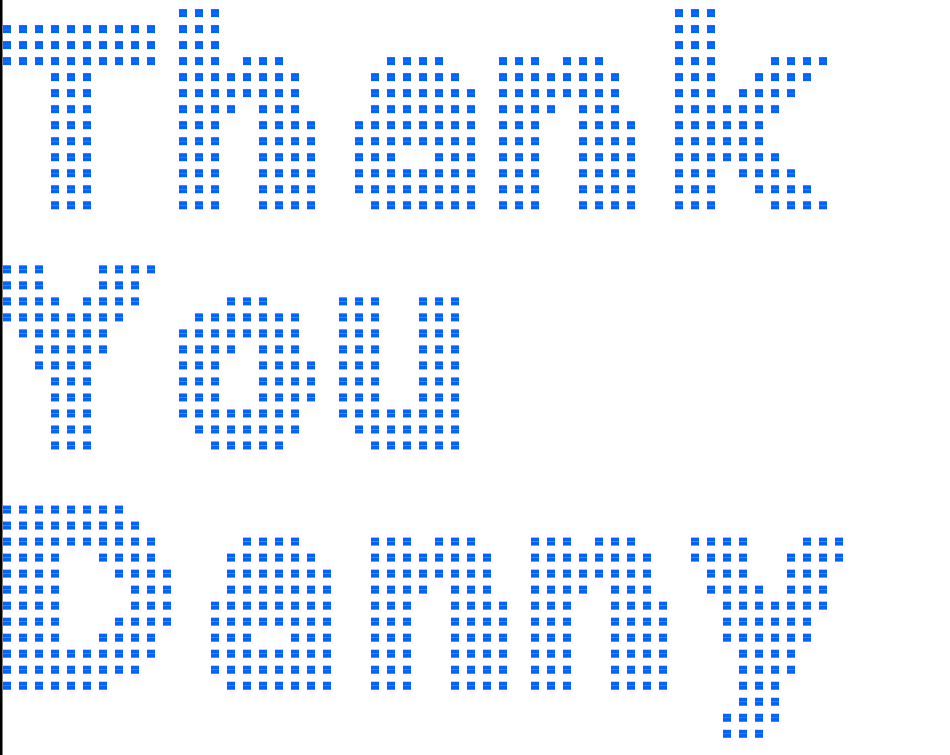Hacking JavaScript Games - Cellular Automata - Supporting Notes
And there are more notes below:
Hacking JavaScript Games - Cellular Automata - Supporting Notes
We will Hack This Game
Cellular Automata Life Game Suitable for Hacking
Supporting Videos
- Change Colour of Cells
- Change Colour Automatically
- Create a Glider Invasion
- Change Size of the World
- Create a Randomly Generated World
- History Of The Game of Life
- Bonus: Making Text With Cellular Automata
Challenge - Change Colour in Cellular Automata
The simplest thing we can do to this game of life is to change the colour.
It is also the most visible thing.
Using the game:
Colour in the Game
In the code we have the World function - which is an object class.
And the World object has an entityColour.
If we can change that, then we can change the colour.
I could use any six values from 0-9, A-F to make an HTML colour code
e.g. http://htmlcolorcodes.com
Change colour by debugging
I set a break point on the line where the colour is set in the sources view.
- Line 153
this.entityColour = "#FF0000";
Then:
- Step over that line so the colour is set.
- press
escto get the console up. - change the colour in the console:
this.entityColour = "#111111";
Change colour from console when runnning game
- change the colour using the console
- inspect element and find where
Worldis instantiated withnew. i.e.ctrl+Fand search fornew World.
var world = new World(worldSizes.myWorldWidth,
worldSizes.myWorldHeight);
And I can change that whenever I want:
world.entityColour = "#111111";
Watch The Video
Change Colour Automatically
Simple - have a bot to change colour every set time interval - say 1000 milliseconds.
The challenge is that I need to use a hex value to do that. So let’s figure that out first.
Random Hex Value
- I can use
0xFFas a Hex integer value, and it is 255 - I can use the
toStringmethod on aNumberto convert a number to a base e.g. base 2 for binary or base 16 for hex: - I need to get a 6 character string, even if my hex value is only
FFand I can do that by creating a string and using the last 6 characters e.g. - And I want my string to be
"0"padded at the front so I’ll just add"000000"at the front of any string: - And I want a Hash
#in front
var myNum=3;
"#" + (("000000" + myNum.toString(16)).substr(-6))
Use Game Random Int Code
The game already has a random number generator:
getRandomInt(0, 0xFFFFFF);
Use that
"#" + (("000000" +
getRandomInt(0, 0xFFFFFF).toString(16)).substr(-6))
And I have a way to generate a random HTML hex colour value.
Randomly set the colour every second
Create a bot to change the colour every 1000 milliseconds.
var colourChangeBot = setInterval(function() {
world.entityColour = "#" + (("000000" +
getRandomInt(0, 0xFFFFFF).toString(16)).substr(-6));
}, 1000);
Stop the bot with:
clearInterval(colourChangeBot);
Make Bot Faster or Slower
Change the value 1000, to make it faster, or slower:
- 500 - every half second
- 200 - every 200 milliseconds
Danger Flashing Lights.
Just be careful you don’t make it so fast that you have a seizure.
Cycle over all the colours
This is a bit slower:
var currColour = 0;
var colourChangeBot = setInterval(function() {
world.entityColour = "#" + ("000000" +
currColour.toString(16)).substr(-6);
currColour++;
if (currColour >= 0xFFFFFF) {
currColour = 0;
}
}, 1)
Watch The Video
References
- http://www.w3schools.com/jsref/jsref_tostring_number.asp
- http://www.w3schools.com/jsref/jsref_substr.asp
An Invasion Challenge
Control the Invasion
Stop the invasion by calling:
stopInvasion();
Start an invasion with:
startInvasion(100);
Where 100 is the amount of milliseconds before the next lifeform is added.
Create a Glider
addLifeForms.glider(world,10,0);
Which creates a glider at position (10,0)
I could create an invasion of gliders like that
var gliderInvasion = setInterval(function() {
addLifeForms.glider(world, 10, 0);
}, 1000);
But an invasion should be random
First stop the old invasion:
clearInterval(gliderInvasion)
Then start our new invasion:
var gliderInvasion = setInterval(function() {
addLifeForms.glider(world,
getRandomInt(0, world.xSize - 50),
getRandomInt(0, world.ySize - 50));
}, 100);
Watch The Video
Change World Size
One of the challenges in the Cellular Automata game is changing the world size.
There is a clue in the game code, because we know that it does some resizing when we change the window size.
worldSizes.calculateScales();
And…
var world = new World(
worldSizes.myWorldWidth,
worldSizes.myWorldHeight);
Let’s Change the World - Make is smaller
worldSizes.myWorldWidth=100;
worldSizes.myWorldHeight=100;
worldSizes.calculateScales();
Let’s Change the World - Make is bigger
worldSizes.myWorldWidth=1000;
worldSizes.myWorldHeight=1000;
worldSizes.calculateScales();
Nope, that didn’t work
Let’s Change the World - Make is bigger
tell the world that it is bigger
worldSizes.myWorldWidth=1000;
worldSizes.myWorldHeight=1000;
world.xSize=1000; world.ySize=1000;
worldSizes.calculateScales();
That worked - and its a little slower now, because thats 1000 x 1000 grid, which is 1,000,000 (1 million) cells!
Simulate ZX-81
The ZX-81 had a resolution of 64x48, and it was black and white, so let’s simulate that.
worldSizes.myWorldWidth=64; worldSizes.myWorldHeight=48;
world.xSize=worldSizes.myWorldWidth;
world.ySize=worldSizes.myWorldHeight;
world.entityColour="#000000";
worldSizes.calculateScales();
And slow it down:
stopInvasion();
stopGame();
startGame(1000);
startInvasion(3000);
Watch The Video
Create A Random World
We first want total control over the game.
- start game
startGame(5)
- stop game
stopGame()
- stop invasion
stopInvasion()
Stop the Game and Clear the world
stopGame();
stopInvasion();
It would be useful to also clear the display.
world.nukeEmAll();
But we’ll only see the results if we start & stop the game again:
startGame(5);
stopGame();
Randomly generate stuff
Reset the population:
world.population = [];
I’ll add items in a loop, and create 100 of them:
for(var itemLoop=0; itemLoop < 100; itemLoop++){
world.addToPopulation(new LifeForm().move(0,
getRandomInt(0, world.xSize),
getRandomInt(0, world.ySize)));
}
Start the game, we should see the results:
startGame(5);
100 might not actually be big enough, you might need to create more for a viable world.
Experiment and Watch the Video
Experiment with different loop sizes to see what works for your world - remember its a harsh world out there for these cells so sometimes you need to start with a lot of them.
History of Game Of Life
John Horton Conway’s Game of Life
Programs to download, install and experiment with:
- Golly
- http://golly.sourceforge.net/
- Also available on IPad and Android
online games of life:
Cellular Automata Life Game Suitable for Playing
Cellular Automata Life Game Suitable for Hacking
Related References:
Good simple Overview
Good set of resources
Wolfram description
History of Computer Game Design - Stanford
Recommended Books
- Artificial Life - by Stephen Levy
- The Garden in the Machine by Clause Emmeche
Watch A Video on the History of the Game of Life

https://www.youtube.com/watch?v=H1rMF7SnGn8
Other Contributions
Danny Dainton experimented with the Game of life and created a ’text’ image.
https://twitter.com/DannyDainton/status/789499155785842688
And he has released thecode for it on github.
https://github.com/DannyDainton/Cellular_Automata_Hacking

Thanks Danny

How to Create Text
I took a different approach to Danny for the text creation:
- I thought it would be easier to write text to the screen
- scrape the pixels
- add the pixels as blocks to the world
First Write the Text
// stop the world and clear the world and screen
stopInvasion();
stopGame();
world.population = [];
clearCanvas();
// plot the text we want
context.font = "14px verdana";
context.strokeStyle="#FF0000";
// kerning hack
// http://stackoverflow.com/questions/8952909/letter-spacing-in-canvas-element
var padding = String.fromCharCode(8202)+String.fromCharCode(8202);
context.strokeText("Thank".split("").join(padding), 0, 15);
context.strokeText("You".split("").join(padding), 0, 30);
context.strokeText("Danny".split("").join(padding), 0, 45);
Then get the pixels and add them to the world
var imageData = context.getImageData(0,0,200,60);
var scale=4; // less than 4 and it will evolve
var imageX=0;var imageY=0;
for (var i=0;i<imageData.data.length;i+=4)
{
if(imageData.data[i]!==0 ||
imageData.data[i+1]!==0 ||
imageData.data[i+1] !== 0){
addLifeForms.block(world, imageX*scale,imageY*scale);
}
imageX++;
if(imageX>=200){
imageX=0;
imageY++;
}
}
Then startGame(5);
Uses?
We could use this for image generation, just with the canvas.
- resize canvas
- create a border
- plot text that shows the size
- save the image
And we could create custom sized images for testing.
Resize Canvas
canvas.width=500;
canvas.height=500;
Create a Border
context.rect(0,0,canvas.width, canvas.height);
context.stroke();
Add Text
context.font = "80px verdana";
var padding = String.fromCharCode(8202)+
String.fromCharCode(8202);
context.strokeText("500px".split("").join(padding), 0, 80);
context.strokeText("500px".split("").join(padding), 0, 160);







